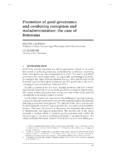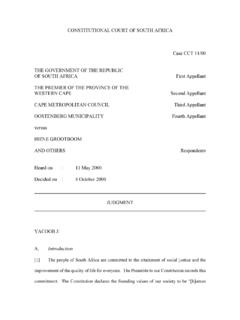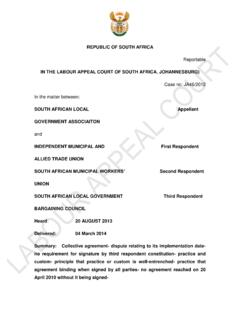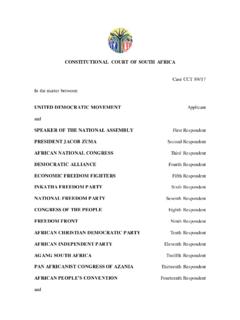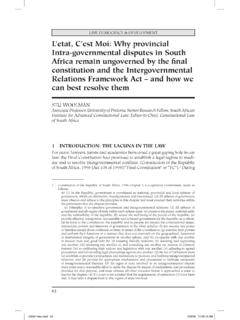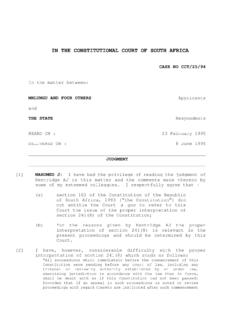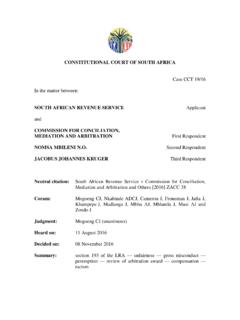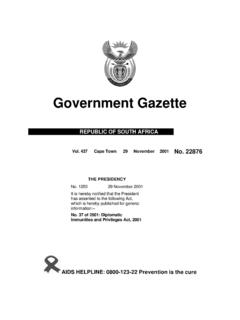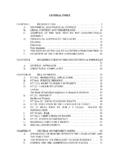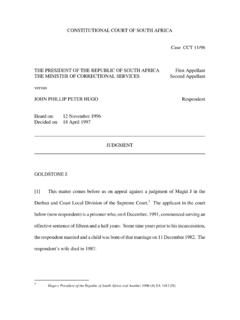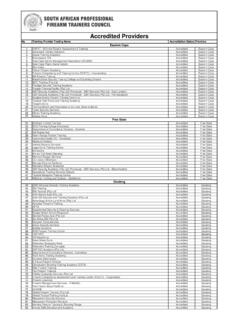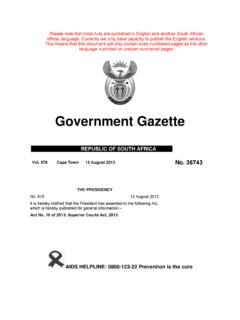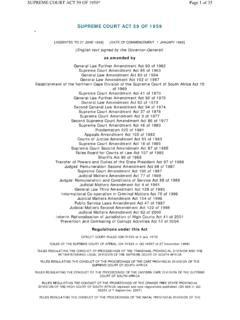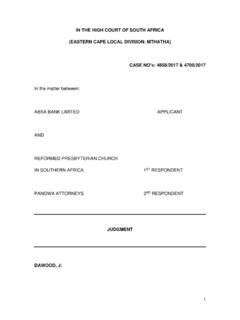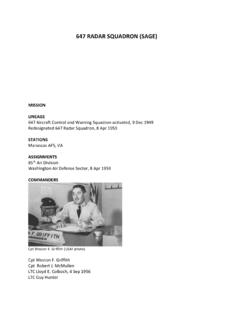Transcription of IN THE HIGH COURT OF SOUTH AFRICA (SOUTH EASTERN …
1 IN THE HIGH COURT OF SOUTH AFRICA (SOUTH EASTERN cape LOCAL division )Case No: 511/03 Date Delivered: 11 April 2003In the matter between:VICTORIA PARK RATEPAYERS ASSOCIATION APPLICANTandGREYVENOUW CC FIRST RESPONDENTCHARLES MELVILLE SECOND RESPONDENTNELSON MANDELA METROPOLITAN MUNICIPALITY THIRD RESPONDENT_____JUDGMENT_____PLASKET AJ:[1] The applicant, a voluntary association, brought an urgent application that I heard on the afternoon of Friday 28 March 2003 in which it sought a rule nisi calling on the first and second respondents to show cause why they should not be committed for contempt of an order that I had made on 21 February 2003 in the case of Nelson Mandela Metropolitan Municipality and others v Greyvenouw CC and I made an order in the terms set out below and undertook to provide my reasons later.
2 Those reasons follow. On 4 April 2003, 1 SECLD 21 February 2003 (case no 3263/02) unreported. The Nelson Mandela Metropolitan Municipality, the first applicant in the initial application, has taken no part in the committal proceedings. It has, however, been cited as the third respondent. When I refer to the respondents in my judgment, such a reference is intended, unless the context indicates otherwise, to be a reference to the first and second heard the application for the committal of the first and second respondent. I reserved judgment. My judgment on the merits follows the reasons for the issue of the rule nisi.[A] THE RULE NISI[2] The order that I made on 28 March 2003 was in the following terms:1)a rule nisi is issued calling upon the first respondent and the second respondent to show cause on Friday 4 April 2003 at 09h30 or as soon thereafter as the parties may be heard why an order in the following terms should not be made the first and second respondents are in contempt of the order of COURT of Plasket AJ made on 21 February 2003 under case reference no.
3 3263/02; a fine, such as is deemed appropriate by this COURT , be imposed upon the first and second respondents in regard to such contempt; a period of imprisonment, such as is deemed appropriate by this COURT , be imposed on the second respondent by this COURT , such period of imprisonment to be suspended on conditions deemed appropriate by this COURT ; relief; the costs of this application on the scale as between attorney and client be paid by the first and second respondents jointly and severally, the one paying the other to be absolved;2)the matter is postponed to Friday 4 April 2003 and the first and second respondents are directed to file their answering papers, if any, by not later than noon on Tuesday 1 April 2003; the applicant is directed to file its replying papers, if any, by not later than noon on Thursday 3 April 2003;3)the issue of costs is [3] Mr Friedman, who appeared for the respondents, argued that I should exercise my general discretion to withhold a remedy2 and decline to issue the rule nisi.
4 In essence, his argument was that, even if a rule nisi does not operate as an interim interdict, it nonetheless has an effect adverse to the interests of a respondent and, in this case, which was brought on about 24 hours notice, the respondent had not been able to place its version before the COURT .[4] As against this proposition, Mr Mouton SC for the applicant argued that it is practice to launch applications for committal for contempt of COURT by way of seeking a rule nisi without necessarily seeking any additional, substantive, interim relief.[5] It appears to me that the main purpose of the practice of seeking a rule nisi in cases such as this is to regulate how the matter is to proceed. Contempt of COURT has obvious implications for the effectiveness and legitimacy of the legal system and the judicial arm of government. There is thus a public interest element in each and every case in which it is alleged that a party has wilfully and in bad faith ignored or otherwise failed to comply with a COURT This added element provides to every such case an element of [6] It has been held that, particularly in matters of urgency, the utilisation of the rule nisi procedure is to be encouraged.
5 In Safcor Forwarding 2 On the discretion to withhold remedies, Baxter Administrative Law cape Town, Juta and Co: 1984, 678 states the position as follows: With the exception of the interdict de libero homine exhibendo (habeas corpus), which is available as of right, all are subject to the discretion of the COURT so that, even if one has established that the action in question was unlawful, the COURT might still refuse to grant the remedy prayed, though it will usually only refuse where the applicant is undeserving. 3 This principle has recently been articulated by a full bench in Federation of Governing Bodies of SOUTH African Schools (Gauteng) v MEC for Education, Gauteng 2002 (1) SA 660 (T), 673D E, in which Kirk Cohen J held that [c]ontempt of COURT is not an issue inter partes; it is an issue between the COURT and the party who has not complied with a mandatory order of COURT .
6 This aspect is dealt with more fully In support of the proposition that the continuing disregard of COURT orders is per se urgent, see Protea Holdings (Pty) Ltd v Wriwt and another 1978 (3) SA 865 (W), 868H 869A; Wright v Saint Mary s Hospital, Melmoth and another 1993 (2) SA 226 (D), 228E (Johannesburg) (Pty) Ltd v National Transport Commission5 Corbett JA stated: The Uniform Rules of COURT do not provide substantively for the granting of a rule nisi by the COURT . Nevertheless, the practice, in certain circumstances, of doing so is firmly embedded in our procedural law.. This is recognised by implication in the Rules (see, eg, Rule 6 (8) and Rule 6 (13)). The procedure of a rule nisi is usually resorted to in matters of urgency and where the applicant seeks interim relief in order adequately to protect his immediate interests. It is a useful procedure and one to be encouraged rather than disparaged in circumstances where the applicant can show, prima facie, that his rights have been infringed and that he will suffer real loss or disadvantage if he is compelled to rely solely on the normal procedures for bringing disputes to COURT by way of notice of motion or summons.
7 The rule nisi procedure must be considered in conjunction with the provisions of Rule 6(12) which, in the case of urgent applications, permits the COURT to: dispense with the forms and service provided for in these Rules and (to) dispose of such matter at such time and place and in such manner and in accordance with such procedure (which shall as far as practicable be in terms of these Rules) as to it seems meet .(And see in this connection Republikeinse Publikasies (Edms) Bpk v Afrikaanse Pers Publikasies (Edms) Bpk 1972 (1) SA 773 (A) at 781H 782G.) In fact, the rule nisi procedure does make it possible for the application to come before the COURT for adjudication more speedily than the usual procedures for the set down of applications or trials, and it does, in a proper case, permit of the granting of interim relief. [7] There is authority for the proposition that, in contempt of COURT cases, the 5 1982 (3) SA 654 (A), 674H 675C.
8 4party alleged to be in contempt because he or she has failed or refused to obey an order is not automatically entitled to be heard while he or she remains in While courts will obviously be loath to refuse to hear a party s defence, and it will only be in the most exceptional of cases that a party may be barred in this way from defending himself or herself, the rule nisi procedure allows the COURT to regulate the respondent s access to COURT , set the bounds of the dispute in the rule so that the respondent is in no doubt as to the case he or she must meet, and set the procedural rules for the further conduct of the matter. [8] Flowing from the above, I am of the view that, from a procedural point of view, the application for a rule nisi as a first step in the committal application was a sensible expedient, especially when it is borne in mind that the matter was an urgent In these circumstances, and on the basis of the applicant s papers only, the applicant established a prima case of contempt of COURT .
9 As a result, it was entitled to the rule nisi that it sought: that relief, it seems to me, was the minimum needed to protect its interests and, at the same time, give recognition and protection to the rights of the respondents, who, after all, had not been heard on the merits at that stage. [9] Mr Friedman urged me to decline to issue a rule nisi because of the harm it could do to the reputation of the respondents in the public eye. They would, he said, be found guilty of contempt of COURT before they were even heard. While one can accept that orders that have no formal legal effect, such as a rule nisi without interim relief, may nonetheless have informal effects in the public domain, one must be careful not to take this argument too far. [10] The truth of the matter is that an application was launched against the 6 See Clement v Clement 1961 (3) SA 861 (T), 867A C; Byliefeldt v Redpath 1982 (1) SA 702 (A), 714E F; Di Bona v Di Bona and another 1993 (2) SA 682 (C), 688A 689J.
10 See too Herbstein and Van Winsen The Civil Practice of the Supreme COURT of SOUTH AFRICA (4ed by Van Winsen, Cilliers and Loots) cape Town, Juta and Co: 1997, 827 828 (hereafter referred to as Herbstein and Van Winsen).7 See Herbstein and Van Winsen, 379 for their committal for contempt of COURT . If erroneous assumptions are made about the import of a rule nisi, or about the mere launching of an application, for that matter, the respondents are free to take steps to correct those assumptions through statements to the media and so on. If the considerations raised by Mr Friedman are taken too far, the functioning of the courts would be unduly and unjustifiably hampered to the public detriment. The remedy available to the respondents lies in the exercise of the right to freedom of expression, rather than in seeking the curtailment of the applicant s rights when it has made out a prima facie case for the relief that it has sought.
